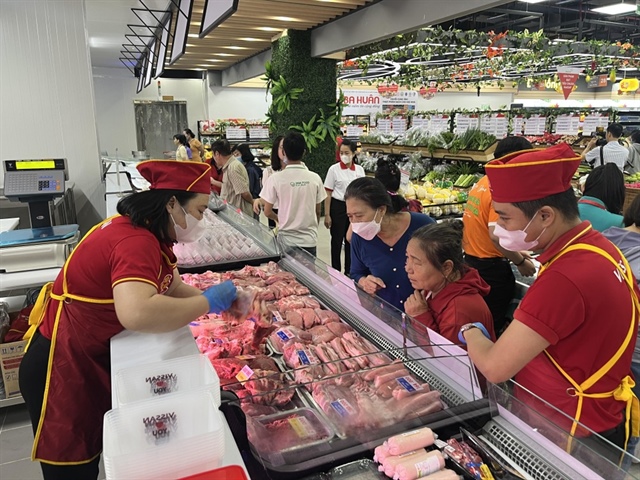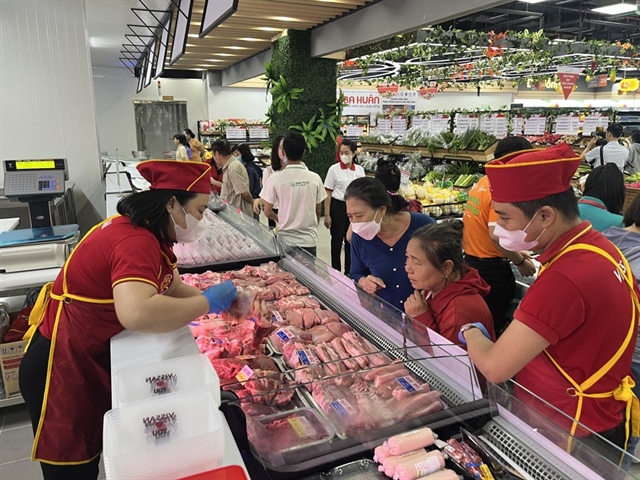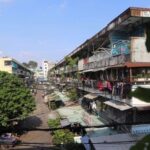The Steering Committee for the Development of the Hog Trading Floor in Ho Chi Minh City (the Steering Committee) has recently submitted a report to the People’s Committee of Ho Chi Minh City on the results of their research on establishing a hog trading floor and proposed a pilot plan for organizing transactions of this commodity through the trading floor.
The need for a hog trading floor in Ho Chi Minh City
Specifically, through the process of studying the establishment of a hog trading floor in the city from 2019 up until now, the Steering Committee has identified certain limitations in the hog supply chain serving the Ho Chi Minh City market.
The supply chain involves multiple intermediary layers, resulting in high logistics costs. Breeders have no decision-making power over the selling price and are entirely dependent on traders. This situation puts both breeders and consumers at a disadvantage.
The transaction methods are still manual, and the market lacks transparency. A small group of large merchants have an advantage in terms of information and business networks, allowing them to influence and control market prices.
The situation of illegal smuggling of live hogs across the border remains complex, posing potential risks of disease transmission and affecting the quality, supply, market prices, and interests of legitimate breeders. This also reduces the competitiveness of the domestic hog farming industry.
Therefore, the formation of a hog trading floor in Ho Chi Minh City is imperative to address the aforementioned issues.
The trading floor is expected to contribute to building a sustainable supply chain, standardizing production processes and product quality, protecting public health, better meeting domestic consumption needs, and aiming for exports.
According to the Steering Committee, Ho Chi Minh City basically meets the necessary conditions to develop a hog trading floor, demonstrating the high feasibility of this model.
Specifically, the city has a large hog consumption market, with a consumption volume of about 10,000 pigs per day and a total value of approximately VND 20,000 billion per year.
The city is home to two large pig meat wholesale markets, Binh Dien and Hoc Mon, which operate stably with an average production volume accounting for about 70% of the total supply to the market. This is a favorable condition for encouraging traders in these markets to participate in transactions through the trading floor.
Ho Chi Minh City’s Market Stabilization Program brings together many large-scale pig meat production and trading enterprises such as Vissan and Sagri, with modern farming and slaughtering processes. This ensures a high-quality source of goods, making it convenient to mobilize their participation in the trading floor during the initial phase.

Ho Chi Minh City has many large-scale enterprises with high-quality goods sources, which is favorable for mobilizing their participation. Photo: TU UYEN |
Pilot for bringing hog trading to the floor within two years
Drawing from the successes and failures of previously implemented commodity trading floor models, the Steering Committee recognizes the need for thorough preparation, practical evaluation, and learning from past experiences before proposing a specific hog trading floor model to ensure feasibility and effectiveness.
Therefore, the Steering Committee submitted to the People’s Committee of Ho Chi Minh City for consideration and approval of the policy to permit a pilot project for organizing hog transactions, based on utilizing and exploiting the existing infrastructure and legal framework of the Vietnam Commodity Exchange (MXV). The pilot period is expected to last for two years.
The People’s Committee of Ho Chi Minh City assigned the Department of Industry and Trade as the standing agency of the Steering Committee, taking the lead in coordinating with relevant departments, branches, and units to perform the assigned tasks.
Specifically, the Department of Industry and Trade will take the lead in signing and announcing a cooperation agreement with MXV on piloting hog transactions on the MXV trading floor to serve the research and development of the project for establishing the Ho Chi Minh City Commodity Exchange in the future.
After the pilot period, the Department of Industry and Trade will be responsible for summarizing the practical transaction results, reporting research results, and proposing a plan for establishing the official trading floor.
The Food Safety Management Department will coordinate with MXV to establish standards, regulations, and inspection procedures to ensure food safety for hog products participating in transactions on the trading floor.
The Department of Agriculture and Rural Development will coordinate with MXV to inspect, evaluate, and select animal slaughter facilities that meet the requirements for participating in supplying hogs for trading floor transactions.
The Hoc Mon and Binh Dien wholesale markets will support and encourage traders to participate in hog transactions on the Vietnam Commodity Exchange.
|
The premise for the formation of the Ho Chi Minh City Commodity Exchange The hog supply chain in Ho Chi Minh City has long been established, with traditional transaction methods that are difficult to change. Individual traders and producers may not immediately see the long-term benefits of the hog trading floor. Therefore, changing the transaction method to the trading floor is expected to require considerable time, effort, and dedication. If the first phase of the hog trading floor is successfully organized and operated, it will be an important premise for proceeding to list and trade other commodities such as poultry meat, seafood, rice, carbon credits, etc. At the same time, this will also serve as a basis for the establishment of the Ho Chi Minh City Commodity Exchange in the future, contributing to the development of a derivatives market, which is one of the important components for developing Ho Chi Minh City into an International Financial Center. |
TU UYEN
The Ultimate Makeover: Unveiling the Revamped Ngo Gia Tu Apartment Project
The urgency of the situation demands swift action from District 10 authorities. The focus should be on finalizing compensation policies and relocation plans for residents affected by the Ngo Gia Tu apartment renovation project. With construction looming, timely and efficient execution of these plans is paramount.
“Proposed Discount Shopping Center in Ho Chi Minh City to Lure Tourists”
“Red tape is a significant hindrance to the growth and prosperity of Vietnam’s business community. This is according to the Chairman of the Business Association in Ho Chi Minh City, who highlights the cumbersome administrative procedures as a key issue facing enterprises today. The current bureaucratic red tape is stifling the dynamic and innovative spirit of businesses, hindering their ability to adapt, grow, and contribute to the country’s economic development.”
The Tân Vạn Interchange: Unlocking the East with a Billion-Dollar Infrastructure Boost
The Tan Van Interchange is an impressive feat of engineering and the largest and most complex interchange on the Ring Road 3. With a staggering investment of over VND 1,800 billion, it serves as a vital gateway for trade and commerce in the East region, seamlessly connecting Ho Chi Minh City, Di An, and Bien Hoa.
“Looking Back and Leaving a Legacy: A Journey Through TA’s Emotional Storytelling”
“TA nhìn lại & để lại” offers a glimpse into the life and legacy of Trần Mộng Hùng, the founder of ACB Bank. This exhibition is not just a showcase of artifacts and memories; it is an emotional journey that brings to life the stories, priceless possessions, and enduring legacies that shaped the bank’s growth and development.
How Much Capital Are Banks Pumping into Ho Chi Minh City’s Real Estate?
As of the end of February 2025, Ho Chi Minh City’s real estate credit balance accounted for approximately 28% of the total credit balance in the area, an increase of 1.15% from the end of 2024. This growth outpaced the overall credit increase, highlighting the vibrant nature of the city’s real estate market and its pivotal role in the local economy.





















